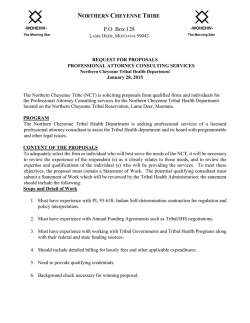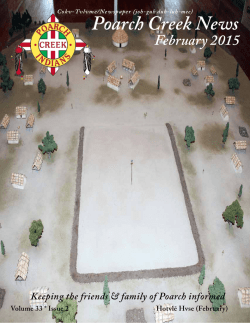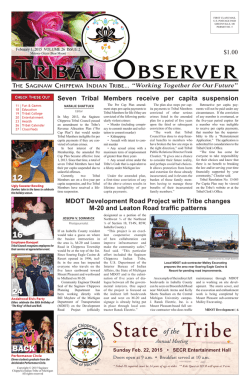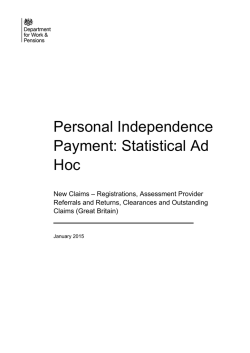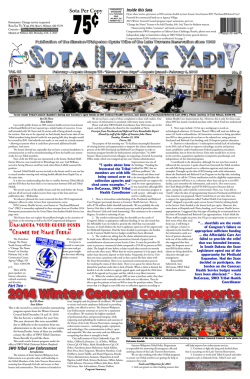
february newsletter 2014 - Big Pine Paiute Tribe of the Owens Valley
February 2015 Tribal Department Contact Information Tribal Administration P.O. Box 700 825 S. Main St. Big Pine, Ca 93513 Office No. 760-938-2003 Fax No. 760-938-2942 Tribal Historic Preservation Office No. 760-938-2003 Fax No. 760-938-2942 Utility Department Office No. 760-938-2003 Fax No. 760-938-2942 Tribal Court Clerk/ ICWA Specialist Office No. 760-938-2003 Fax No. 760-938-2942 Environmental Department Office No. 760-938-2003 Fax No. 760-938-2942 CDD Housing Department Office No. 760-938-2003 Fax No. 760-938-2942 Education Center Office No. 760-938-2530 Fax No. 760-938-3125 BP Paiute Development Corporation Office No. 760-938-2800 Fax No. 760-938-2942 Household Hazardous Waste Collection Event Big Pine Transfer Station Saturday February 7, 2015, 9:00 a.m. to 12:00 noon Items Accepted Paints/Stains Solvents Oil/Oil Filters Anti-Freeze Herbicides Bleach/Cleaners Pesticides Old Diesel/Gas Insecticides Transmission Fluid Disposal sites can accept no more than 20-gallons per visit in no larger than 5-gallon containers. Clear out old stuff for safety and peace of mind! Contact the Tribal Environmental Department for more information or assistance. Do You Care About Air? By Sally Manning, Environmental Director We are immersed in air like a fish is immersed in water. However, I’ll bet few of us spend much time thinking about this light, transparent medium called air. To give it a thought may give pause: Of things external to oneself, one is more intimate with air than with anything else. Every few seconds, 24 hours a day, for perhaps 7 million breaths a year, we inhale air deep into our lungs. In anatomical diagrams, lungs look like two big wings enveloping the heart. The moist and delicate lining of the lungs offers a surface area about the size of a tennis court for the air to be absorbed. Air crosses membranes to enter the bloodstream and cells. Air becomes part of us, which is good if we are breathing oxygen which fuels our life, but bad if we are breathing particles or chemicals. Some unwanted air components are exhaled, others stick in the lung’s lining, but many are absorbed where they may disrupt metabolic processes. The U. S. Clean Air Act calls upon the nation to develop, then achieve, clean air standards. Scientists have advised us on acceptable levels of certain pollutants in our air. Levels are often set based on probabilities, risk tolerances, and lots of statistics. In truth, to our lungs, there is no “healthy” level of air pollution. Human bodies function best, and we tend to live longer, if we are free from dealing with pollutants entering our lungs. Gravity holds air above the surface of the land and oceans, where we need it to be. Otherwise, the air is free to move. It circulates around the earth with limited predictability and oblivious to political boundaries. This means that what you do to air may stay in the air! Wood smoke and dust have always been generated by people, and after being suspended for a while, these particles typically settle to the ground. In modern times, however, we are directly and indirectly responsible for constant releases of a huge variety of air pollutants, from: emissions from the cars we drive; chemicals from manufacturing and decomposition of the plastics and other items we consume; and the gases from the power plant that fuels the lights in our home. Air affects you and almost everything you do affects air. Keep that in mind, and consider how earth can be made better, not worse, by our actions. By Sally Manning, Environmental Director The New Year started with some grim news about the state of planet. Checking the NASA (National Aeronautics and Space Administration) website (http://climate.nasa.gov/news ) on January 16 revealed the following headlines: 2014 Warmest Year in Modern Record The year 2014 ranks as Earth’s warmest since 1880, according to two separate analyses by NASA and National Oceanic and Atmospheric Administration (NOAA) scientists. The image shows earth’s average temperature in 2014. More intense red (hot) colors show progressively greater increases from average, and more blue color shows where on the planet temperatures were cooler than average. The news also reported that 2014 was the hottest on record for California. Visualization Shows Rapid Decline of Arctic Sea Ice http://climate.nasa.gov/news/2220/ - NASA invites you to go online and watch the north polar ice cap shrink over the past 35 years. This icy region was a thriving ecosystem, but it is now rapidly changing. The changes threaten many animals that call the region home, such as polar bear, walrus, whales, and others. Rivers Are Draining Greenland Quickly As seen in the above image showing higher temperatures in 2014, Greenland, the world’s largest island, has been warmer. A huge ice sheet occupied about 75% of the island. However, with warmer temperatures, the ice is rapidly melting. Rivers are forming, which drain the meltwater to the surrounding sea. The meltwater contributes to global sea level rise, a phenomenon being experienced in places like Venice, Italy, and Norfolk, Virginia. Year 2007 2008 2009 2010 2011 2012 2013 2014 Average temp. for year, degrees F, +/- Standard deviation Max, date 60.9 +/- 18.9 105.7 13.3 July 5 Jan. 14 59.9 +/- 18.8 59.8 +/- 18.1 59.8 +/- 18.5 58.7 +/- 17.8 61.2 +/- 18.3 60.6 +/- 18.1 62.1 +/- 16.8 Min, date 101.2 15.1 July 9 Dec. 27 100.9 14.5 July 17 Dec. 9 102.5 20.8 July 19 Jan. 23 100.3 20.8 July 2 Jan. 1 103.8 14.4 July 11 Dec. 20 105.2 11.6 June 30 Dec. 6 102.6 20.4 July 13 Dec. 29 Dates missing? (% of data points present) Yes, some in May and Dec. (91.5%) Yes, in Nov. (99.6%) No (100%) Yes, Feb.–Mar. (88.4%) No (100%) Not really (99.9%) Are temperatures rising in Big Pine? Statistically speaking, you can’t tell with data from the Tribe’s Met station: the period of record is short. Average annual temperatures are shown in the table at left. The numbers are intriguing. For example, one might note that the lowest recorded minimum temperatures don’t seem as low as they used to be or could be. Rising winter temperatures, with or without higher summer maximum temperatures, can lead to a higher annual average. Is a higher average temperature really a higher temperature? Yes: Ask an ice cube! Not really (99.7%) Scattered days, incl. July 2-3 (98.7%) BE GREEN AND KEEP YOUR RECYCLABLES CLEAN! By Levi Mallory, Environmental Technician Help Us Help You to a Better Earth. Once you put your recyclables on the curb, they aren't processed right away. Let's say you put your recycling out every other week, that's already plenty of time for stuff to start spoiling and rotting. Then your recyclables go to the Tribe’s Recycling Center, where they're sorted and weighed, before going to either the Transfer Station or Landfill. At this point, they might sit around in the County’s recycling bins for weeks or even months before they're sold to a reprocessing facility. Now imagine your jar of half-eaten, four-month-old mayonnaise, lounging about in a stuffy warehouse and getting riper by the day. Not pleasant, is it? Take it from me, it’s a real day wrecker when you get rotten milk, or any spoiled food for that matter, on your clothes or skin. It really is appreciated when people take a few seconds to empty and rinse out recyclables. Here are a few general good pointers to practice at home: Empty is preferable: It’s greener to consume or at least appropriately dispose of the food/drink/cleaning product in containers before placing them in the recycling bin. In addition to attracting vermin and upping the ick factor in your bin for the brave personnel who have to handle it, excess debris in your recycling bin requires extra energy to clean and recycle. Rinsing: When rinsing, it’s usually a good call to let the containers dry first, or at least shake all liquids out of containers to help keep the paper and cardboard goods in your bin clean and recyclable. Conserve water when you rinse: Scrape food out first with a spoon or rubber spatula, then swish a little bit of water around in the container versus letting it sit under a running faucet. If you have several containers to rinse at once, just fill up a bowl and use the same warm water for the whole job. Most liquid bottles can simply be emptied and placed in your bin (and the drier, the better, so as to prevent them from reducing your recyclable papers to mush), but a quick rinse of sugary drinks or milk does help. Jars and tubs that once held stickier foodstuffs – your margarines, mayonnaises, and mustards – present a bit more challenge, but you don’t need to use additional water to get those empties in tip-top shape. Wiping out wide-mouth containers with a used napkin or paper towel (don’t forget, you can compost that!), saves water. The Lower Owens River Project: Will DWP Hold the LORP Hostage? Observations by Sally Manning, Environmental Director Water has been flowing for 8 years now in what is called the “Lower” Owens River. The Lower Owens had been dry for decades after DWP completed the LA Aqueduct in 1913. They diverted the river into the aqueduct at a location east of Aberdeen, and much of the lower river channel, as well as Owens Lake, went dry as a result. When Inyo County and DWP entered the Water Agreement (1991), it called for a project to re-wet the Lower Owens River. The Lower Owens River Project (LORP) serves as mitigation for most of the adverse impacts to Owens Valley caused by DWP’s water diversions and groundwater pumping since 1970 when the second barrel of the aqueduct was completed. A series of lawsuits was ultimately necessary to force DWP to implement the LORP, and flows finally began at the end of 2006, which was more than four years behind schedule. One quirk of the LORP is that, although DWP is required to release flows into the old river channel, they also were allowed to pump the water back up to their aqueduct once it completes its journey down the LORP. DWP built a “pumpback station” on the LORP, south of Lone Pine. The various agreements and court orders limit DWP’s pumpback capacity to 50 cubic feet per second (cfs) (24 hours per day, year round). DWP is required to maintain flows in the LORP at 40 cfs, and some years, they may release a brief pulse flow (200 cfs or less) to “mimic” a more realistic river flow regime. To date, the 50 cfs limit on the pumpback station has been sufficient for DWP to pump back just about all of the water that flows all the way down the channel. DWP and Inyo County annually release a report on conditions in the LORP. The 2014 report shows many positive trends in this part of Owens Valley since the rewatering began. For example, vegetation throughout the river floodplain quickly greenedup: there are meadows, shrubs, willows, ponds, and marshes. Bulrushes and cattails – collectively known as tules -- have definitely been thriving: they line the channel and fill wet depressions, creating shade, nesting, food, and protection for wildlife. Many fish species and a wide variety of birds are seen in abundance. Ranchers use fences to limit cattle access to the river, but tule elk, beaver, and other mammals use the river. People visit to fish or bird-watch and perhaps to paddle and swim. Water quality data show no serious nutrients, chemicals, or salt, but summer water temperatures do climb to a range that could stress fish (e.g. bass, bluegill, catfish, etc.). However, during the warmest days of summer, fish find refuge in the tules and cooler places. Despite these and other successes with the project, there are concerns. DWP has always wanted the ability to pump more. They have been trying to get others to agree with them that lifting the limit on the pumpback station, thus allowing flows in excess of 50 cfs, to perhaps even 75 cfs or more, would be a good idea, one that would benefit the LORP. Working with their consultants, Inyo County staff, and a handful of citizens, the “story” being presented is that the LORP is suffering. To hear them speak, we hear of tules choking the river, gobs of muck accumulating on the riverbed, minimal germination of cottonwoods and tree-willows, and water quality so poor all the fish might suddenly die. To rescue the river from this hypothetical brink of ecological collapse, a slightly modified flow regime has been proposed. While the modified flow regime is pretty much like the current flow regime, there would be a “catch” to accepting the new one: DWP must be allowed to exceed the 50 cfs pumpback limit. Ecologically, the change to the pumpback limit makes absolutely no difference with regard to the effectiveness of the new flow regime; rather, DWP is taking advantage of some people’s interpretation of current conditions and offering a questionable remedy which has some significant strings attached. The problem with the deal? Once DWP is free to do more pumping at the pumpback station, they will have every incentive to tap groundwater resources throughout a huge area of the valley they haven’t yet pumped. This area lies east (downslope) of the LA Aqueduct, from Aberdeen to Owens Lake, where DWP owns about 60 square miles of land. If there is agreement on the LORP deal, over the years, new wellfields will spring up in that region of the valley, and the LORP will become simply the “third barrel” of the LA Aqueduct. DWP will have turned a hard-won mitigation project into a conduit for increased pumping of Owens Valley aquifers and more water export to Los Angeles. How is the LORP a hostage? DWP is saying, “You want a healthier LORP? Then you must allow us to pump without court -imposed limits.” In my view, the LORP is doing quite well, and I think it’s best left alone for the time being. It’s beginning only its 9th year of flow after decades of being dry. Succession, which is the gradual path to ecosystem recovery, is happening, and it’s expected it may take several more years for the system (channels, trees and other plants, and animals, etc.) to more fully adjust to the reintroduction of water. By Joseph Miller, Community Garden Specialist With spring coming up and summer around the next turn preparing our home and property for fire protection is a high priority. The current drought conditions are creating a vast amount of fire fuel in the form of dry weeds and brush making fire a very foreseeable hazard to our homes. Fire threat can be minimized by implementing a few simple plant maintenance steps and landscaping tricks to protect your home. Look for Immediate Vulnerabilities The area immediately surrounding your home should be free from any dead dry plant material. Trim and clear all shrubs and trees in close proximity to windows and eves to prevent fire from laddering and climbing vertically from potential fire fuel to your home. Extreme care should be taken to keep this area free of all materials that could ignite during or after a flame front such as tumbleweeds and trash. Firewood should be stacked away from your home and not stacked along wood fences. Create Defensible Space An area of defensible space allows firefighters to better defend your home if a wild land fire erupts. Reducing the amount of fire fuel (weeds, brush, trees) will increase your defense against a wildland fire. Flower beds and high volume plant areas should be kept clear and trimmed so they do not create continuous fire fuel beds. Trim and prune tree limbs so there is adequate space between trees to prevent fire from spreading above the ground. Plant Appropriate Vegetation The BPPT Environmental Office can help you pick plants to grow around your home that can slow down an oncoming wild land fire and help you to avoid plants that quickly ignite posing danger to your home. Utilizing these tips will help you prepare, manage and protect the spaces surrounding your home. Please be aware and vigilant when clearing and burning weeds around your home. It only takes one spark or ember to ignite dry fire fuel type materials. Hopefully we can all do our part and become or continue to be fire wise together. More information on fire wise gardening and defensible space is available at the BPPT Environmental office or at these sites http://www.readyforwildfire.org/landscaping or http://www.napafirewise.org/. News from the Tribal Historic Preservation Office by Bill Helmer, Tribal Historic Preservation Officer Inyo County Board of Supervisors and Planning Department Sued by the State of California’s Attorney General’s Office for California Environmental Quality Act (CEQA) Violations for the Munro Valley Solar Project On January 8, 2015, the Inyo County Planning Department and the Board of Supervisors were sued by the Native American Heritage Commission (NAHC) over CEQA violations for the Munro Valley Solar Project. The California State Attorney General’s Office is trying the case for the NAHC. It is not known at this time the status of the case, but further developments will be posted in this newsletter. Big Pine Paiute Tribe Submits Comments to Inyo County for the Renewable Energy General Plan Amendment (REGPA) draft Programmatic Environmental Impact Report (PEIS) The letter from the Big Pine Paiute Tribe is available upon request. The following is an excerpt from the letter: Consider Alternative Approach to Solar Development in Inyo County The Tribe supports renewable energy alternatives, as well as energy conservation, in the country’s search to minimize dependence on fossil fuels and reduce greenhouse gas emissions. Despite the Tribe’s opposition to the REGPA, the Tribe is supportive of better planning for solar energy production. The Tribe suggests alternatives, such as: Amend the General Plan (if needed) to accommodate solar energy development in areas of the county already zoned for commercial and/or industrial development. Implement county code Title 21 and evaluate proposed solar projects on a case-by-case basis. Each EIR would be produced at the project proponent’s expense, then carefully analyzed by the public (including the Tribe) to assess environmental advantages and impacts. Create county policy that clearly states that Inyo County is not available for industrial solar. Designate more Inyo County Environmental Resource Areas (ERAs). This could be done by following through with the county’s General Plan commitment to establish more ERAs in the county. The Tribe and perhaps many in the general public may be interested in assisting in this effort, and conservation areas proposed in the Desert Renewable Energy Conservation Plan (DRECP, currently available in draft form for public review), for example, could be used to accomplish this. ERAs would attract tourists. Assign county staff to seek grant funding to assist/incentivize installing of solar panels on local businesses, offices, residences, etc. within our built environment. Develop the PACE approach or a similar model. The above are suggestions, and there are probably other ways in which Inyo County could be proactive in embracing and implementing solar technology. The days in which Inyo County reacts by accommodating development by institutions outside the county, at the expense of the county’s resources and long-term livelihood, must be ended. BIG PINE PAIUTE TRIBE TO COMMENT ON THE DESERT RENEWABLE ENERGY CONSERVATION PLAN (DRECP) Comments on the Draft Environmental Impact ReportEnvironmental Impact Statement for the DRECP are due February 23, 2015. The DRECP will pave the way for large scale solar development projects in large areas of the Mojave Desert, including portions of the Owens Valley. The Tribal Council and staff will be meeting with BLM in early February in order to obtain more details about the proposal. Below is a map from the Preferred Alternative for the DRECP which shows a Development Focus Area (DFA) [area in red] where large scale solar developments would be streamlined for permits. One of the questions we will be asking BLM, the agency who is coordinating input on the DRECP, is why the area immediately east of Lone Pine and the Lone Pine Paiute-Shoshone Indian Reservation was chosen for large scale solar development. Proposed Development Focus Area (DFA) in the Lone Pine area. SCENES FROM THE OWENS VALLEY... Moon setting over the Sierra Nevada, dawn, near Independence, January 5, 2015. Cloud above Big Pine, nearing sunset, November 14, 2004. From the desk of Rhonda Willis, Tribal Administrator Manuhu, this weather has been fantastic but we will pay for it in the summer months if we do not receive enough rain. We need to take advantage of this weather and start cleaning up the debris, weeds, and excess vehicles from your assignments. Not only will this make it safer for the Reservation but it will also give your neighbors a more pleasant view of the Sierras and the Whites. We live in the beautiful Eastern Sierras so let’s do our part to enhance that. The Public Safety Officer and the Reserves will be enforcing the Dog Ordinance. There have been numerous complaints, bites and dogs ran over this past month. You need to read and understand the consequences of not complying with the New Dog Ordinance adopted July 8, 2014. Your dogs are to be licensed and tagged and not to be running in the roads or on others land assignments. Please be courteous to others and keep your dogs and Tribal Members safe. Just a friendly reminder that if you would like to be on the Tribal Council or General Council agenda those agenda request forms need to be submitted 10 days prior to the meeting. Council will not be adding last minute requests on the day of the meeting. We are trying to confirm dates for February to have a speaker come and talk with us in a public forum about Public Law 280. This will inform us of our rights on the Reservation and where law enforcement is concerned. What jurisdiction does law enforcement have on the Reservation and where do we supersede? There are so many questions and misunderstandings of the law when it comes to what is right or wrong within the boundaries of the Reservation. California is a Public Law 280 state where some states are not. There may be different laws here that do not apply on a Reservation in a different state and vise versa. I would like to invite everyone to come out that evening and listen to what is said and ask questions so that there is a better understanding of the law. We will get out the notices once our presenters have a confirmed date and time. If I can be of help or answer questions, please feel free to give me a call. Winter Wellness Camp a Great Time for Youth! The first ever Too-Wano Togi Nawanaki Winter Wellness Youth Camp was held January 17-19, 2015 at the Sierra Adventure Center (Bernasconi). We had nineteen total participants and everyone really enjoyed themselves. Collaboration in this project began back in September of 2014 between the Big Pine Tribe Administration, Education and Environmental departments, OVCDC TANF, Aka Mya Cultural Group and Inter-Tribal Council of California. The workshops covered topics such as Healthy Teen Relationships, Bullying 101, Leadership, Social Media Etiquette, Drug and Alcohol Abuse, History of Our Culture, Handgame, Healthy Self-Image, Digital Storytelling and Archery. The topics were presented in a teaching format, but mixed with games that illustrated the basic message and allowed the kids to interact with each other. Because a camp without crafts isn’t any fun, the kids were able to decorate t-shirts as part of The Clothesline Project, a domestic violence awareness effort. After viewing a couple videos on domestic violence, the kids designed and created t -shirts that they were able to take home. We were fortunate to have good weather the whole time, making our off-site trips to Keough’s, the petroglyphs and Glacier Lodge possible. The kids were also allowed free time to play basketball or just hang out. We hosted a bonfire and told local legends, followed by roasting marshmallows and eating s’mores. After that, to warm up, the kids were given hot chocolate, popcorn and other movie snacks while we watched The Avengers. Sunday night, the kids were able to show off their fancy footwork at a dance! DJ Sage Smoke kept the crowd entertained with his mix of tunes, light shows and several dance contests. All in all, everyone had a great time! The kids put together a short movie called “The Camp,” based on the local Goatman legend which is viewable through the Tribe’s Facebook page (be sure to check out the bloopers after the feature). Thank you to everyone who donated their time, equipment and expertise to this project. Dove Jeude, Danielle Brewster, Barbi Olson, Marie Saenz, Sage Romero, Bobby Piper, Bill Eddy, Sookaaki Charley, Brock Romero, Tiffany Chavez, Alan Bacock, Yolanda Cortez, Cruz Chapparo, Joseph Miller, Rosie Moose, Amber Spratt, Roxanne Spratt, Rhonda Willis, Big Pine Tribal Council, Education Department and Environmental Department, this weekend would not have been nearly as successful, or even possible without you all! Thank you again! We will begin planning for next year’s camp in July, for those who are interested in helping. CDD Staff Housing Manager To Be Announced C o m m u n i ty D e v e l o p m e n t D e p a r t m e n t H o u s i n g Pr o g r a m Project Manager James Davis Maintenance Technician Jose Rico Housing Counselor Secretary Danelle Bacoch-Gutierrez Housing Committee Chairwoman Nancy Madina Vice–Chairwoman Janet Gutierrez Secretary Jessica Barr Member Roseanne Moose Tribal Council Representative Genevieve Jones, Chairwoman Mountain Lion alert A mountain lion was heard in the Big Pine Creek near Callina Street area in the early morning hours a couple of days ago. Dogs were on both sides of the creek barking, which resulted in the mountain lion being trapped in the creek. Quite a commotion was made by all animals and you could hear the mountain lion in the water swishing very loudly & hissing very madly!! Please be aware of our natural habitat, that like to roam freely, as they can pose a threat to our safety and be very dangerous. Please be alert when walking in early morning & evening hours. ~Friendly Reminder~ Annual Re-certifications and Housing Inspections for Rentals and Homebuyers will be scheduled and mailed for all housing participants of CDD. Please contact the CDD office if you need to reschedule the date and time assigned to your home. Thank you 2015 College-Vocational 2015 ICDBG Grant Awarded CDD Housing Program was awarded a 2015 ICDBG grant which will assist in the operations of the Housing Department and providing rehabilitation work on homes. Rehabilitation projects are currently being worked on by Project Manager, James Davis and the Work Force Crew; Dean Spratt, Jim Sepsey, Thomas Spratt and Jack Sepsey. Student Housing Assistance Program Congratulations to Talicia Frankson! She was selected by the CDD Housing Committee to be a recipient of the CDD College Vocational Student Housing Assistance Program. The program assists students with their rent payments while they attend out of the area colleges. Amounts awarded are $750.00 per semester. Look for notices, and ask for applications, during the 2015 Fall Semester. Housing Payments Please remember to stay current on your house payments; if not paid by the 10th of each month you will have a late fee assessed of $25.00. If arrangements need to be made for a payback agreement, please contact the Housing Office at 760.938.2003 Housing Applications Please update your housing applications. This must be done every year. Housing Committee Meetings Are held every third Wednesday of the month at 6pm in the Tribal Chambers. Maintenance Reminders Check your smoke alarms. Don’t run extension cords under carpets. You should plug your space heater directly into walls. Check all wires to make sure they are not faulty. Conserve water. Chimney sweep, make sure combustibles are not near fireplaces & heaters. February 21, 2015 9:00 a.m., to 1:00 p.m. Big Pine Elder’s Building at 841 S. Main Street Baked goods and other items Elders are holding a Fund Raiser to purchase Bingo equipment and other miscellaneous supplies needed. Contact Dorothy Stewart, Marion Zucco, or Roberta Hunter for more information. Dorothy Stewart: (760) 938-2398 Marion Zucco: (760) 938-2072 Roberta Hunter: (760) 938-2446 INDIAN GAMING REVENUE SHARING TRUST FUND (IGRSTF) DISTRIBUTION DEADLINES (For College, Trade School, Technical School & Certificate Programs) To be eligible for the IGRSTF, all students must be enrolled in at least six (6) credits/units or enrolled in an accredited college, trade/technical school or certificate program. The following documents will be accepted as proof of enrollment: Most recent quarter/semester grades, Program progress reports, and/or official written verification of current enrollment. Submitted documents must show the student’s name, & name of college, trade/technical school or certificate program. Documents must be submitted to the Big Pine Tribal Office, located at 825 South Main Street, Big Pine CA by mail, fax, email or in person. Verification of enrollment in a College, Trade/Technical School and/or Certificate Program must be submitted to the Big Pine Tribal Office by the following deadlines. QUARTERS DEADLINE TO SUBMIT VERIFICATION DOCUMENTS st 1 Quarter (January, February, March) January 31 2nd Quarter April 30 (April, May, June) 3rd Quarter July 31 (July, August, September) 4th Quarter October 31 (October, November, December) IMPORTANT: Failure to submit all necessary verification(s) by the above deadlines will affect your eligibility to receive the IGRSTF distribution(s). February 2015 Sun 1 8 Mon Tue 2 3 TERO Meeting 6:00 p.m. Environmental Advisory Board Meeting 6:00 p.m. Elders Meeting 10:00 a.m. 9 Land Assign. Meeting 6:00 p.m. 10 Cultural Meeting 12 noon Wed Thu Fri Sat 4 5 6 7 11 12 13 14 Tribal Council Meeting 6:00 p.m. Enrollment Meeting 6:00 p.m. Household Hazardous Waste, BP Transfer Station Happy Valentine's Day! Recycle 15 16 17 Holiday OFFICE CLOSED 18 Housing Meeting 6:00 p.m. 19 Tribal Council Meeting 6:00 p.m. 20 21 Elders Bake Sale E.D.C. Meeting 6:00 p.m. Recycle 22 23 24 Recycle 25 Commodity Foods Distribution 8a.m.-12p.m. 26 27 28 Big Pine Paiute Tribe of the Owens Valley P.O. Box 700 ● 825 South Main Street Big Pine, Ca 93513 Phone No. 760-938-2003 ● Fax No. 760-938-2942
© Copyright 2025
